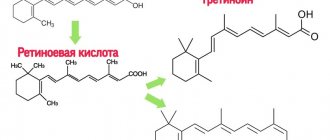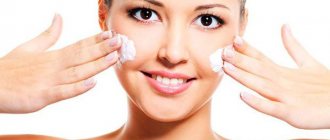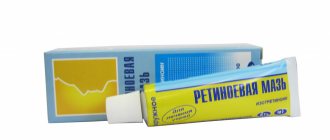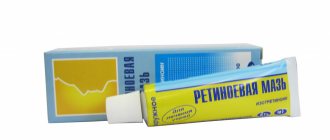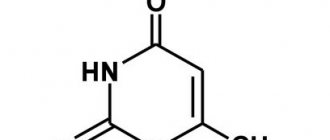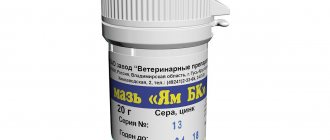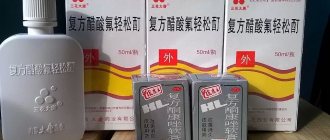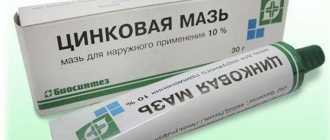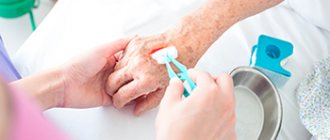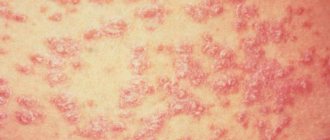From this article you will learn:
- Is retinoic ointment effective for wrinkles?
- retinoic ointment for wrinkles - reviews from doctors and patients.
The article was written by a specialist with higher medical education.
Retinoic ointment belongs to the group of topical retinoids. Its main active ingredient is Isotretinoin (13-cis-retinoic acid), which is, in principle, one of the most effective forms of vitamin A for reducing the depth of wrinkles.
Thus, the effectiveness of Isotretinoin significantly exceeds the effects of using most other forms of vitamin A. Everyone has heard about cosmetics with retinol, retinaldehyde, as well as retinol acetate - all of these are forms of vitamin A that are different in effectiveness. Compared with isotretinoin, a stronger anti-aging effect on The skin is treated only with a retinoid such as Tretinoin (retinoic acid).
Composition and release form
Retinoic ointment is a greasy, light-yellow product of uniform consistency, which contains Isotretinoin. It is this substance that determines the high biological activity of the drug. Isotretinoin belongs to the group of Retinoids and is a type of retinoic acid along with Tretinoin, which is more toxic and for this reason is rarely used.
Retinoids are substances close in structure and physiological action to Vitamin A - Retinol, and are chemically similar to it.
For clarity, the relationship between the chemical structure of vitamin A and its derivatives is shown below.
Isotretinoin is shown on the left and is completely cis-retinoic acid, that is, its chemical configuration in which the functional group is in the same plane as the double bond. Cis isomers are more reactive, i.e. have greater biological activity. In addition, it is safer than trans-retinoic acid - Tretinoin .
To date, among the six drugs registered in Russia, Isotretinoin Retinoic ointment is the only dosage form in the form of an ointment.
Therefore, if you come across a drug in the pharmacy in the form of an ointment or cream with a different name, where this active substance is indicated, then keep in mind that this is a counterfeit or fake.
The patent and rights to produce this ointment belong to the pharmaceutical industry.
Retinoic ointment is available in two concentrations:
0.5% - containing 0.05 g of Isotretinoin per 10 g of ointment and 1% containing 0.1 g, respectively.
The ointment also contains auxiliary components:
- Dibunol (antioxidant, antioxidant);
- Butyloxyanisole (antioxidant, preservative, acidity regulator);
- Emulsion wax (emulsifier);
- Vaseline oil (lipophilic base);
- Glycerin (density regulator, solvent, has a moisturizing effect on the skin);
- Ethyl alcohol (solvent, preservative);
- Purified water.
Description of the drug
Patients often ask dermatologists how long they can apply a topical product to their face to eliminate acne. The doctor answers the question only by conducting a series of laboratory and sometimes instrumental studies. If the cause of acne is external factors, then a month of treatment is enough. And when the pathology is diagnosed, simultaneous treatment of acne and the underlying disease is carried out. It can last 6-12 weeks.
Isotretinoin is produced in several dosage forms:
- ointments;
- capsules;
- rectal suppositories.
In the treatment of severe rashes, the external form of vitamin A is used, and capsules are taken orally.
Specialists rarely resort to this method of treatment due to the very toxic effects of systemic drugs. During acne therapy, foods high in sugar and fat are excluded from the diet. It is necessary to drink at least 2 liters of clean still water daily. This will significantly increase the clinical effectiveness of Retinoic ointment and speed up recovery.
Clinical and pharmacological group
Retinoic acne ointment is part of the pharmacological group of topical retinoids. The variety of medicinal properties also allows us to classify it as a dermatoprotector and antiseborrheic agent.
Release form and composition
Retinoic ointment is produced in many domestic pharmaceutical factories. 0.05% and 0.1% external agent are packaged in 10.0 g in aluminum tubes. Secondary packaging is a cardboard box with an attached annotation. In addition to isotretinoin, the drug consists of the following components:
- dibunol;
- emulsion wax;
- glycerin;
- purified water;
- butyloxyanisole;
- Vaseline oil;
- 95% ethanol.
Many of the additional ingredients exhibit weak therapeutic antiseptic activity. They also accelerate the absorption of isotretinoin into inflammatory lesions and promote its uniform distribution.
The combined composition of Retinoic ointment allows it to be used against spots and blackheads. Excipients dissolve and draw out the contents of comedones. And ethanol and dibunol:
- accelerate exfoliation of the epidermis;
- discoloring pigment spots.
Glycerin and petroleum jelly retain moisture in the cells and prevent infection of the skin pores.
The optimal temperature for storage is 2–8 °C. Approximately this mode will ensure the location of the drug on the side shelf of the refrigerator.
Retinoic ointment should not be stored for longer than 24 months. It must be taken into account that after the seal of the tube is broken, the shelf life is limited to 2 weeks. The drug should not be used if a foreign odor appears or the consistency changes.
The average cost in pharmacies is 365 rubles.
How does Retinoic ointment work?
Compared to other Retinol derivatives, retinoic acids and Isotretinoin in particular have a shallower penetration depth, which means less absorption into the body, and therefore less likelihood of serious side effects when used exclusively externally.
Vitamin A is fat-soluble, like all its derivatives. They are always in alliance with carriers - fats and fat-like substances, which means, like all fats, they penetrate the skin well.
Side effects
Burns from retinoic ointment are a common side effect and consequence of retinization. Such burns usually go away on their own after short-term withdrawal of the drug. Repeated use should be resumed with a smaller amount of a lower concentration in order to allow the skin to get used to and adapt.
Retinization is the saturation of the skin with retinoid products, in other words, their “accumulation” in the skin as a result of regular use.
This concept has two consequences:
The first is stimulation of all processes of skin cell renewal;
The second is severe skin irritation, accompanied by burning, sometimes pain and even “corrosion” of the skin, which, however, is very rare when using ointment.
The latter property underlies the action of retinoic peels.
More serious side effects are associated with the effect on the fetus.
Isotretinoin, like other retinoids, can cause deformities in the fetus, i.e. is teratogenic. Even small concentrations of the drug can cause deformities, so it’s not worth the risk. Consequently, drug therapy with this substance is carried out exclusively in women who are not pregnant or planning a pregnancy, using at least two reliable methods of contraception simultaneously, both during treatment and for the next one to two months after.
No foreign doctor will prescribe this drug to you without setting the above condition. In addition, all women who use this drug, especially in the form of tablets, are entered into a special register and their health status is monitored.
But in Russia, many dermatologists neglect this rule, not to mention monitoring women’s health when using external medications, which are called almost a panacea for everything: from wrinkles to acne.
And that is not all. When treating acne in men with Isotretinoin tablets or long-term therapy and applying Retinoic ointment to large areas of the skin (larger than the palm area), the substance can penetrate into the seminal fluid, so partners are also strongly recommended to use double contraception.
Separately, I would like to say about cosmetic preparations containing retinol and its derivatives.
There are many cosmetic preparations that contain a fairly high content of retinoids, so you should always remember:
- Cosmetics are subject to less stringent requirements than drugs;
- For cosmetics, bioavailability and the percentage of the substance entering the systemic circulation are not taken into account;
- There are also associated side effects that can have an irreversible effect, and especially no one will tell you about possible teratogenicity;
- Few cosmetic preparations have detailed instructions indicating side effects and warnings, the maximum that can be written is “consult a cosmetologist, may cause an allergic reaction, in case of contact with eyes, rinse them with plenty of water”;
- You cannot know for sure what side effects are fraught with certain cosmetic products, even your cosmetologist may not know, and manufacturers simply have not studied this aspect or are silent.
Retinoic ointment for wrinkles - reviews from dermatologists
Using drugs from the retinoid group to treat skin diseases, dermatologists found that the skin also became firmer, smoother, and the depth of wrinkles decreased. These effects were studied, and it turned out that Isotretinoin, which is part of the retinoic ointment, can significantly rejuvenate facial skin with long-term use.
Main effects of Isotretinoin –
- improves skin texture (by exfoliating dead skin cells),
- improves skin color,
- increases skin thickness and elasticity,
- reduces the secretion of sebaceous glands,
- stimulates the activity of fibroblasts in the dermal layer of the skin, which leads to stimulation of the production of collagen, elastin and hyaluronic acid. As a result, skin elasticity increases, the depth of wrinkles and fine lines on the face decreases.
Optimal concentration and timing of use of Isotretinoin to reduce wrinkles -
In the article devoted to Isotretinoin, we analyzed in detail all clinical studies that studied the optimal concentration and timing of isotretinoin use for the treatment of skin photoaging and reduction of wrinkle depth.
Conclusions from clinical studies - firstly, the optimal treatment period is at least 36 weeks. Secondly, the choice of concentration will depend on your goals: it can be either only the prevention of skin photoaging, or the need for significant changes in the skin (reducing the depth of wrinkles, increasing its thickness and elasticity).
If you only need to prevent photoaging, then it is best to use Retinoic ointment with a 0.05% concentration of Isotretinoin. Moreover, this must be done in combination with sunscreens that have a protection factor of at least SPF 30. As a result, you will get an improvement in skin color and texture, plus excellent prevention of wrinkles.
If your skin already has signs of photodamage, fine lines and wrinkles, then you need to use Retinoic ointment with a 0.1% concentration of Isotretinoin. However, during the first few weeks, doctors still recommend using 0.05% retinoic ointment first. This is due to the fact that lower concentrations at the initial stage will allow the skin to get used to the action of retinoids, and significantly reduce redness and irritation of the skin.
Keep in mind that you will see the first positive changes only after 8-12 weeks. Before this, you will definitely go through a short period of deterioration of your skin, when your skin will become flaky, dry, red, itchy and sensitive. Therefore, you should be patient. If you dare to use Retinoic ointment to treat acne and pimples, which, in our opinion, is unacceptable (the fatty components of the ointment, on the contrary, clog the pores) - prepare for a sharp worsening of acne in the first weeks.
Important: Isotretinoin-based preparations (including retinoic ointment) can indeed be used to reduce the depth of wrinkles, but it is still best to use them only in patients with sensitive or dry skin. This is due to the fact that Isotretinoin is significantly inferior in its effect on collagen synthesis to a retinoid such as Tretinoin.
But Tretinoin has significant side effects associated with severe redness and dry skin, which allows it to be prescribed only to patients with oily or normal skin (24stoma.ru). Therefore, for patients with dry and sensitive skin, it is customary to prescribe products with isotretinoin, because Although they are weaker, they have significantly fewer side effects.
Contraindications
Retinoic ointment has clear contraindications for use, including:
- Pregnancy, including planned;
- It is also contraindicated in nursing women due to the possibility of passage into breast milk;
- Hypersensitivity and skin damage, the cause of which is not clear;
- Too thin and dry facial skin;
- Vitamin A hypervitaminosis;
- Fatty liver and lipid metabolism disorders;
- Treatment with tetracycline antibiotics;
- Treatment with other retinoids.
Indications for use
According to the official instructions for the use of Retinoic ointment, there are only a few indications for its use:
- Acne;
- Seborrheic dermatitis;
- Rosacea;
- Perioral dermatitis (“jams”, cracks in the corners of the lips).
However, given the positive effects of this ointment, there are several non-trivial indications for which it can be used, among them:
- Treatment of fresh scars, scars and stretch marks;
- Treatment of post-inflammatory hyperpigmentation, post-acne (after acne and wounds);
- Reduction of facial and age wrinkles that appear due to decreased skin turgor;
- Treatment of ingrown hairs after depilation.
Rules of application
Although this drug is intended for the skin regardless of location, Retinoic ointment is still more often used specifically for the facial skin.
Let's consider the methods and features of its use in each specific case, but before that it is worth learning a few general recommendations:
- Treatment with the drug should be started with a lower concentration, especially for those who use this drug for the first time;
- For people with very thin and sensitive skin, it is recommended to mix a small amount with Vaseline oil 1:1, gradually increasing the percentage of ointment, this way you will be able to avoid burns on the skin;
- Treatment should be continued for at least a month (as for most retinoids) provided there are no adverse reactions;
- When using Retinoic ointment under the eyes, do not apply it close to the eye, especially in high concentrations;
- When applying around the eyes, retreat 1-1.5 cm from the eye, apply in a thin layer and do not rub into the skin, but rather use the advice from step 2;
- Under no circumstances should this product be applied in the form of a mask in a thick layer over the entire face, this can lead to disastrous consequences;
- The ointment should be applied in a thin layer locally, only to the affected area, unless the doctor prescribes otherwise.
For acne and blackheads
As a remedy for acne, retinoic ointment is applied in a thin layer to the affected areas 2 times a day. It is necessary to apply the composition to cleansed, dry skin and do not cover it with creams or other products. During the treatment period, it is better for girls to avoid decorative cosmetics in the affected area. Yes, it is not easy, however, the result is worth it.
Drugs from the retinoid group are currently the most effective treatments for all forms of acne.
Why do we choose them?
Because they have a beneficial effect on all processes occurring in the skin when acne occurs - they reduce the production of sebum and facilitate its secretion, normalize keratinization, reduce inflammation, and prevent the growth of pathogenic microbes in the pilosebaceous follicles.
Systemic (internal) retinoid therapy
(Roaccutane or high doses of retinol palmitate) is usually used for severe forms of acne. For mild forms, it is more advisable to prescribe external agents with 13-cis-retinoic acid (isotretinoin). The domestic drug Retinoic ointment is available in two concentrations - 0.1% and 0.05%, which corresponds to the content of 13-cis-retinoic acid (isotretinoin). The ointment is made on an emulsion basis (that is, it has the consistency of a light moisturizing cream), has a yellowish color, is odorless, is easily applied to the skin and absorbed. What concentration to choose, what guidelines to use in order to maximize the clinical effect? This article is devoted to these issues.
A study of the safety of retinoic ointment at all three concentrations showed that the ointment does not have an allergenic, carcinogenic, mutagenic, embryotoxic or teratogenic effect.
At the beginning of the treatment of papulopustular and comedonal acne, use Retinoic ointment 0.1% to achieve maximum effect in a shorter time. The exception is people with thin, sensitive skin (mainly blondes, red-haired people and children), who initially use an ointment of a lower concentration (0.05%), increasing it if it is well tolerated, usually after 2-3 weeks. The ointment is applied twice a day in a thin layer to the affected areas (facial skin, if necessary, back and chest). When using a high concentration ointment on the face, do not apply it to the eyelids, area around the eyes, lips, corners of the mouth and at the entrance to the nose, and also avoid getting the drug on the mucous membranes to avoid irritation.
Almost all patients on the 5-8th days of treatment experience an exacerbation reaction, manifested in an increase in the number of rashes, moderate redness and peeling of the skin, sometimes dry lips, itching. The reaction lasts from 3 days to 2 weeks, does not require additional therapy and disappears on its own, giving way to persistent improvement. In case of a pronounced exacerbation reaction, stop using the ointment for several days until it subsides. Despite the fact that the instructions for use of the ointment mention the possibility of such a reaction, it is better to warn the patient about it. Our experience shows that it is sometimes regarded by patients as intolerance to the drug and treatment is stopped. It is better to schedule your next visit to a dermatologist 10-14 days after the start of treatment; it is at this time that patients have questions and doubts, they need support and confidence that everything is going as it should. After the exacerbation reaction subsides, improvement is noted - the oiliness of the skin gradually decreases, and resolution of the rash is observed. This favorable trend continues throughout the treatment period (usually 3 months), which does not exclude the appearance of a small number of new eruptive elements. There are usually no other side effects.
The best result is achieved with comedonal acne - cleansing of comedones and reducing skin oiliness occurs within 14-21 days. Deeply located closed comedones become more superficial. With papulopustular acne, pustules (pustules) and comedones resolve first, followed by inflammatory elements; spots, cystic elements and scars are the most resistant to treatment.
To increase the concentration of the ointment in those patients for whom it was considered more appropriate to start treatment with retinoic ointment 0.05%, it is better to choose a period when 7-10 days have passed after the exacerbation reaction has subsided.
What is considered drug intolerance? How to distinguish it from an exacerbation reaction and choose the right tactics for managing the patient?
In some cases, after the first application of the ointment to the skin, the patient is bothered by a burning sensation, itching, and redness occurs. With repeated applications, these phenomena are repeated and intensified, the erythema spreads to neighboring areas, swelling of the skin occurs, redness, rashes in the form of small spots and nodules, and peeling occur. If intolerance occurs, the drug is discontinued, further treatment is carried out with drugs from other groups (not from the retinoid group!). The tactics for treating intolerance phenomena correspond to those of allergic rashes. Intolerance differs from an exacerbation reaction in the timing of its onset, the rapid development of symptoms, the presence of swelling and induration, the appearance of rashes unusual for acne that are not confined to the mouths of the pilosebaceous follicles, and the spread of rashes beyond the application of the ointment.
It should be noted that an initial burning sensation that goes away after a few seconds can be observed in people with sensitive skin if the drug is well tolerated. It is due to the presence in the ointment of a small amount of alcohol used as an antimicrobial substance.
During treatment with retinoic ointment 0.1%, another phenomenon may occur - an overdose of 13-cis-retinoic acid. Clinical manifestations of its excessive accumulation in the skin are the appearance of flaky red spots both in the places where the ointment was applied and nearby (on the neck, abdomen, shoulders, forearms, hands). Subjectively, mild itching and a feeling of increased sensitivity of the skin in places of contact with clothing, as well as when touched, are noted. In such cases, there are 2 options - stop using the ointment until these phenomena resolve, and then start using it again at a lower concentration, or immediately reduce the concentration. An overdose occurs closer to the end of the course of therapy - in the second or third month of treatment.
The use of retinoic ointment 0.05% is indicated in the following cases:
- For thin, sensitive skin prone to irritation;
- In case of excessive accumulation of retinoic acid in the skin (overdose);
- In conditions of increased solar radiation;
- As a transition period to maintenance therapy;
- For conglobate acne in the period between courses of systemic therapy.
The first two cases have already been discussed above.
Trips to southern resorts, moving to a climate zone with a hotter climate, as well as the summer period in the middle zone, are associated with increased insolation. Retinoic ointment increases skin sensitivity to sunlight. In this regard, it is better to use a lower concentration of ointment, switch to a single (at night) application of the ointment, and also use sunscreen when going out in the sun.
How to combine the use of retinoic ointment and sunscreen? Studies have shown that within 1 hour after applying retinoic ointment, its concentration in the skin reaches its maximum level. Based on this, it is recommended to apply sunscreen an hour after retinoic ointment. If too much ointment has been applied, then the excess remains on the skin, giving it an untidy, greasy appearance. In this case, before applying sunscreen, the skin can be treated with tonic, lotion, and wiped with a damp or dry cloth. The recommended level of protection is 30-40 SPF, while on the beach and for persons with sensitive thin white skin and blond or red hair - up to 60 SPF.
Upon successful completion of the main course of treatment (3 months) with retinoic ointment 0.1%, it is necessary to smoothly transition to maintenance therapy. During the transition period (1-2 months), it is recommended to use retinoic ointment 0.05% initially 2 times a day, then once at night.
After completing a course of systemic therapy with retinoids (roaccutane or retinol palmitate) for conglobate acne, the use of local retinoid therapy is also indicated - retinoic ointment 0.1% or 0.05%, depending on the condition of the skin.
Conclusion
Retinoic ointment
- a good external treatment for mild forms of acne vulgaris. The presence of two concentrations of the ointment makes it possible to make treatment more effective, provide maintenance therapy, quickly respond to skin changes by changing the concentration, and avoid overdose without losing the therapeutic effect of the drug.
prof.
IN AND. Albanova Print
Analogs
This unique drug has many effects and indications, so for each of them we have indicated separate analogues.
For clarity, analogues of Retinoic ointment are divided into groups, which can be seen in the table.
Retasol
Isotretionin preparation in the form of a 2.5% solution for external use. Contains propylene glycol and ethyl alcohol as auxiliary components. The higher concentration is due to the liquid dosage form. The main indications are also:
- Acne;
- Seborrheic dermatitis;
- Rosacea;
- Perioral dermatitis.
Due to its higher concentration, Retasol is not recommended for use on thin and damaged skin, especially under the eyes. Also, the liquid form is less effective for use against wrinkles.
The solution must be stored in the refrigerator.
We see
It is an ointment containing Retinol - Vitamin A. The remaining components are almost the same as Retinoic ointment, only the antioxidant components differ. The compositions of the products can be compared in the table .
| Retinoic ointment | Ointment Videstim |
| Dibunol | Butylated hydroxytoluene |
| Butyloxyanisole | Butylated hydroxyanisole |
| Emulsion wax | Emulsion wax |
| Vaseline oil | Vaseline oil |
| Glycerol | Glycerol |
| Ethanol | Ethanol |
| Purified water | Purified water |
The manufacturer is also
The official instructions for Videstim ointment include a number of indications for which this product can be used, including:
- Eczema;
- Dermatitis, including atopic dermatitis in the absence of exacerbation (i.e. in remission);
- Excessive pigmentation (cheilitis), including age-related;
- Age-related skin changes (meaning wrinkles); diseases associated with impaired skin keratinization processes, such as hyperkeratosis;
- To activate skin restoration processes after glucocorticosteroid therapy.
Features of application
There is an opinion that a good retinoic ointment rejuvenates the skin only after it causes irritation. This is true. Retinoic acid has some irritating effects. Therefore, before the effect of skin tightening becomes noticeable, the face may turn red and begin to peel.
Note: the effect of redness and irritation is stronger when using ointment, and weaker when using cream or gel.
Due to the irritating effect, cosmetologists are recommended to start treatment with 0.05% ointment . The minimum concentration of isotretinoin allows the skin to “get used to it”. Afterwards, switch to 0.1%
.
In addition, it is important to choose the right treatment regimen. To avoid irritation and burns, the course of acne treatment is divided into 4 weeks and the following scheme is used:
- 1st week - ointment is applied at night after 3 days.
- 2nd week - ointment is applied at night after 2 days.
- 3rd week - ointment is applied at night every other day.
- 4th week - ointment is used every night.
It is important to consider: the composition is not applied where the skin is thin and vulnerable (for example, it is not recommended to apply it around the eyes ).
Retinoic ointment for age spots
Pigmentation is the appearance on the skin of spots with a different shade ( lighter
or
darker
). Treatment of pigmentation is determined by the cause of its appearance. In most cases, the skin needs nutrition, and sometimes whitening components.
With some stretch, retinoic ointment can be called a remedy for age spots . It promotes the formation of new cells, which over time returns the skin to its normal color. However, the effectiveness of the retinoic composition against spots is very small.
Retinoic ointment for stretch marks
Stretch marks on the abdomen are a cosmetic defect that forms on the skin of the abdomen in pregnant women. It is difficult to treat. Restoring the original appearance is possible with complete renewal of the skin. Therefore, you can use retinoic ointment for stretch marks, but this will not always completely remove this defect.
